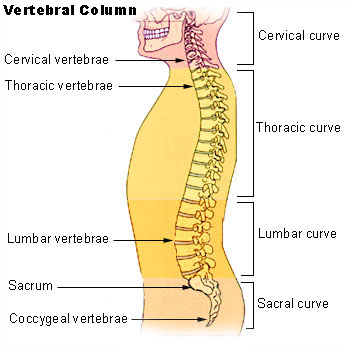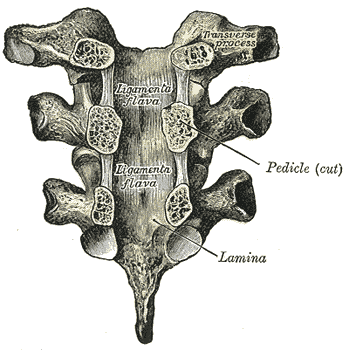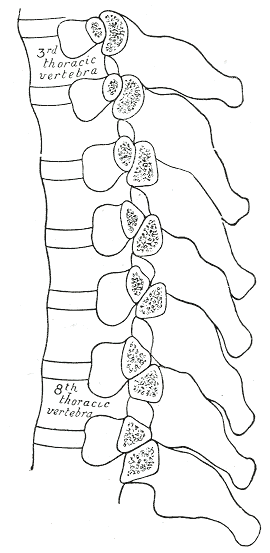Thoracic vertebrae
Editor-In-Chief: C. Michael Gibson, M.S., M.D. [1]
Overview
The 12 thoracic vertebrae compose the middle segment of the vertebral column, between the cervical vertebrae and the lumbar vertebrae. They are intermediate in size between those of the cervical and lumbar regions; they increase in size as one proceeds down the spine, the upper vertebrae being much smaller than those in the lower part of the region. They are distinguished by the presence of facets on the sides of the bodies for articulation with the heads of the ribs, and facets on the transverse processes of all, except the eleventh and twelfth, for articulation with the tubercles of the ribs.
General characteristics
These are the general characteristics of the second through eighth thoracic vertebrae. The first and ninth through twelfth vertebrae contain certain peculiarities, and are detailed below.
The bodies in the middle of the thoracic region are heart-shaped, and as broad in the antero-posterior as in the transverse direction. At the ends of the thoracic region they resemble respectively those of the cervical and lumbar vertebrae. They are slightly thicker behind than in front, flat above and below, convex from side to side in front, deeply concave behind, and slightly constricted laterally and in front. They present, on either side, two costal demi-facets, one above, near the root of the pedicle, the other below, in front of the inferior vertebral notch; these are covered with cartilage in the fresh state, and, when the vertebrae are articulated with one another, form, with the intervening intervertebral fibrocartilages, oval surfaces for the reception of the heads of the ribs.
The pedicles are directed backward and slightly upward, and the inferior vertebral notches are of large size, and deeper than in any other region of the vertebral column.
The laminae are broad, thick, and imbricated — that is to say, they overlap those of subjacent vertebrae like tiles on a roof.
The vertebral foramen is small, and of a circular form.
The spinous process is long, triangular on coronal section, directed obliquely downward, and ends in a tuberculated extremity. These processes overlap from the fifth to the eighth, but are less oblique in direction above and below.
The superior articular processes are thin plates of bone projecting upward from the junctions of the pedicles and laminae; their articular facets are practically flat, and are directed backward and a little lateralward and upward.
The inferior articular processes are fused to a considerable extent with the laminae, and project but slightly beyond their lower borders; their facets are directed forward and a little medialward and downward.
The transverse processes arise from the arch behind the superior articular processes and pedicles; they are thick, strong, and of considerable length, directed obliquely backward and lateralward, and each ends in a clubbed extremity, on the front of which is a small, concave surface, for articulation with the tubercle of a rib. *
Individual thoracic vertebrae

First thoracic vertebra
The first thoracic vertebra has, on either side of the body, an entire articular facet for the head of the first rib, and a demi-facet for the upper half of the head of the second rib.
The body is like that of a cervical vertebra, being broad transversely; its upper surface is concave, and lipped on either side.
The superior articular surfaces are directed upward and backward; the spinous process is thick, long, and almost horizontal.
The transverse processes are long, and the upper vertebral notches are deeper than those of the other thoracic vertebrae.
The thoracic spinal nerve 1 (T1) passes out underneath it.
Second thoracic vertebra
The thoracic spinal nerve 2 (T2) passes out underneath it.
Third thoracic vertebra
The thoracic spinal nerve 3 (T3) passes out underneath it.
Fourth thoracic vertebra
The fourth thoracic vertebra, together with the fifth, is at the same level as the sternal angle.
The thoracic spinal nerve 4 (T4) passes out underneath it.
Fifth thoracic vertebra
The fifth thoracic vertebra, together with the fourth, is at the same level as the sternal angle.
The thoracic spinal nerve 5 (T5) passes out underneath it.
Sixth thoracic vertebra
The thoracic spinal nerve 6 (T6) passes out underneath it.
Seventh thoracic vertebra
The thoracic spinal nerve 7 (T7) passes out underneath it.
Eighth thoracic vertebra
The eighth thoracis vertebra is, together with the ninth thoracis vertebra, at the same level as the xiphoid process.
The thoracic spinal nerve 8 (T8) passes out underneath it.
Ninth thoracic vertebra
The ninth thoracic vertebra may have no demi-facets below. In some subjects however, it has two demi-facets on either side; when this occurs the tenth has only demi-facets at the upper part.
The thoracic spinal nerve 9 (T9) passes out underneath it.
Tenth thoracic vertebra
The tenth thoracic vertebra has (except in the cases just mentioned) an entire articular facet on either side, which is placed partly on the lateral surface of the pedicle.
The thoracic spinal nerve 10 (T10) passes out underneath it.
Eleventh thoracic vertebra
In the eleventh thoracic vertebrae the body approaches in its form and size to that of the lumbar vertebrae.
The articular facets for the heads of the ribs are of large size, and placed chiefly on the pedicles, which are thicker and stronger in this and the next vertebrae than in any other part of the thoracic region.
The spinous process is short, and nearly horizontal in direction.
The transverse processes are very short, tuberculated at their extremities, and have no articular facets.
The thoracic spinal nerve 11 (T11) passes out underneath it.
Twelfth thoracic vertebra
The twelfth thoracic vertebra has the same general characteristics as the eleventh, but may be distinguished from it by its inferior articular surfaces being convex and directed lateralward, like those of the lumbar vertebrae; by the general form of the body, laminae, and spinous process, in which it resembles the lumbar vertebrae; and by each transverse process being subdivided into three elevations, the superior, inferior, and lateral tubercles: the superior and inferior correspond to the mammillary and accessory processes of the lumbar vertebrae. Traces of similar elevations are found on the transverse processes of the tenth and eleventh thoracic vertebrae.
The thoracic spinal nerve 12 (T12) passes out underneath it.
Additional images
-
Vertebral column.
-
Vertebral column.
-
Vertebral arches of three thoracic vertebræ viewed from the front.
-
Section of the costotransverse joints from the third to the ninth inclusive.
References
See also
External links
- Interactive tool to identify parts
- Template:NormanAnatomy
- Photos at University of Utah
- SpineUniverse anatomical diagram
Template:Spinal nerves Template:Bones of torso
ca:Vèrtebra dorsal de:Brustwirbel et:Rinnalülid it:Vertebra toracica lt:Krūtinės slankstelis nl:Borstwervel sv:Bröstkota


